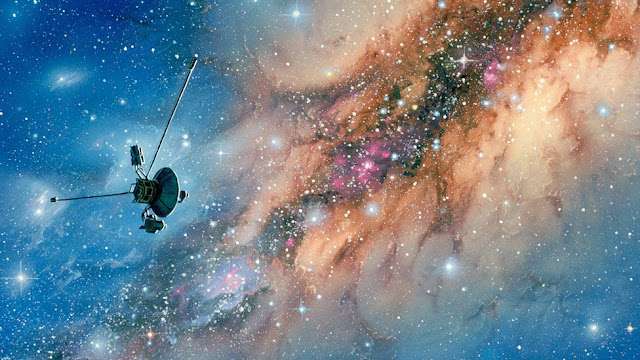Voyager 1 Is Sending Back ‘Impossible’ Data From Interstellar Space
In the vast expanse of interstellar space, where the void between stars stretches into infinity, Voyager 1, humanity’s emissary to the cosmos, continues to astonish scientists with its remarkable resilience and groundbreaking discoveries. Launched by NASA on September 5, 1977, Voyager 1 embarked on a mission to explore the outer reaches of our solar system and beyond. Now, nearly five decades later, it has ventured beyond the influence of our sun and into the uncharted territory of interstellar space.

Recent data transmitted by Voyager 1 has left scientists scratching their heads and rewriting the textbooks. The spacecraft, which is over 14 billion miles (22.5 billion kilometers) away from Earth, is beaming back signals that defy conventional understanding. These “impossible” data challenge our current understanding of the interstellar medium and shed new light on the dynamics of the universe beyond our solar neighborhood.
One of the most perplexing observations from Voyager 1 is the detection of a constant, low-frequency humming sound. This enigmatic signal, dubbed the “Voyager Hum,” is unlike anything previously recorded by the spacecraft. Scientists speculate that it could be the result of interactions between charged particles in the interstellar medium and Voyager’s instruments. However, the precise origin and nature of this hum remain a subject of intense debate among researchers.
Another puzzling phenomenon observed by Voyager 1 is the presence of fluctuating magnetic fields that oscillate in ways never before seen. These magnetic fluctuations defy the expected patterns and suggest the existence of complex, unseen forces at play in interstellar space. Some scientists theorize that these anomalies could be evidence of exotic astrophysical phenomena, such as magnetic reconnection events or turbulence on a cosmic scale.
Furthermore, Voyager 1 has detected a curious increase in the density of interstellar plasma compared to previous measurements. This unexpected rise in particle density challenges existing models of the interstellar medium and prompts scientists to reconsider their understanding of the dynamics governing these vast expanses of space.
The discoveries made by Voyager 1 in interstellar space have far-reaching implications for our understanding of the universe. They force us to question long-held assumptions and inspire new avenues of research into the mysteries of the cosmos. As Voyager 1 continues its solitary journey through the depths of space, it serves as a beacon of human ingenuity and exploration, pushing the boundaries of what we thought possible and expanding our cosmic perspective.
However, as Voyager 1 pushes ever deeper into the unknown, its aging instruments are beginning to falter, and its power supply dwindles. Eventually, its transmissions will cease, and it will drift silently through the cosmos, a relic of humanity’s quest for knowledge. But until that day comes, Voyager 1 will continue to send back invaluable data, enriching our understanding of the universe and inspiring future generations to reach for the stars.
In the end, Voyager 1’s “impossible” data remind us of the boundless wonders that await us in the cosmos and the limitless potential of human exploration. As we marvel at the mysteries revealed by this intrepid spacecraft, we are reminded that the universe is vast, strange, and full of surprises, waiting to be explored by those with the courage to seek out the unknown.
Reference: NASA

Very cool! Go voyager!!!